The world is crazy right now with the GT86 and Subaru BRZ, telling how "wonderful they are to drive" and "how cheap they are". But let's wake up for a moment from the dream and face reality: They cost £30,000, and applying our magic "buying advice" formula, this would mean being able to pay £12,000 in cash, and face a monthly payment of £450 over four years. No, it is not within the reach of every pocket, especially if you consider that the sports car is the second car at home, the one to enjoy from time to time. We are told that it spends little and that it is cheap to insure and maintain, but, although it is true that it doesn't spend as much as the sports cars of yesteryear, I think that the Elise I'm going to talk about today, if you meet certain characteristics, will be a much more sensible and interesting purchase.
The Elise was the reinvention of Lotus. Its salvation from complete disappearance, and the reunion with the most mythical Lotus. Before it, the company had launched the Elan M100 as a revival with which to win back hearts in the UK and beyond, leaving the Esprit as the house's halo supercar.
But the Elan had many problems right from the start. For starters, it opted to be front-wheel drive, pulling a lot of components from General Motors (then temporary owner of Lotus). To continue, it practically coincided in its launch with the Mazda MX-5, which ate it in sales by being a more successful reinterpretation of what a traditional British roadster had to be, with a competitive price and rear-wheel drive.
But the worst thing about the Elan was that it was very expensive to produce. So much so that Lotus lost more money making it than it made selling it.
It had to be killed and succeeded. From conception to production, a documentary team was with the development team that created this mid-engined sports car, creating a documentary that I've posted below for your enjoyment, and which will reveal all its secrets if you have a couple of hours to spare and high English skills.
But beyond the development process... what is the Elise? The Elise is a sports car with an aluminium chassis made of extruded profiles, glued and riveted together, fiberglass bodywork, with two seats and a small four-cylinder engine placed in a central transverse position, just behind the passengers, driving the rear wheels.
A simple car, very, very light (the first S1 weighed 731 kilograms!), economical, and above all, designed to be pure driving fun.
But let's start, as usual, with the aesthetics.
Design
The design of the Elise is captivating, even more so if you see it in person. It is a small car, very small, compact, low, which integrates in its forms many elements crossed from great sporty designs of other brands and times. Julian Thompson (currently working at Jaguar Land Rover), its creator, said that in his catalog of ideas for the Elise had pulled elements such as the air vents on the hood of the Ferrari F50, the cross side air intakes of a Ford GT40 (which also had air outlet on the hood to the F50), and many other elements.
But no, it's not a collage. The Elise has its own personality, a personality that comes out of the pores. The best thing is that, although its aesthetic is from the mid-nineties, not only does it turn heads today, but it still looks contemporary. That Julian Thompson is a design genius is something that was demonstrated with the Elise, a car that continues to influence him in his current works (Jaguar C-X75, sound familiar?).
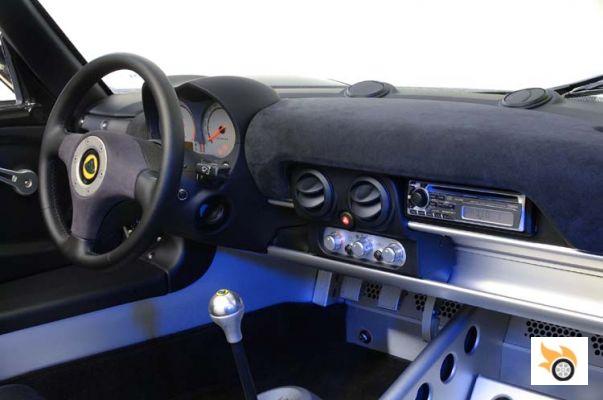
If the outside of the car is charming, accessing the cabin is the first step that will test your love for the world of automobiles.
The traverse to overcome on the threshold of the door is of epic proportions. The dashboard is minimalist and beautiful. In its own way. Just by looking at it, if you're a techie and minimalist nut, you'll see how the cross strut of the dashboard is part of the visible, as are many elements of the lower part of the cabin. The pedals have their own aluminium extrusions, and the gear lever looks more like something out of a World Touring Car from a couple of decades ago than a thoroughbred sports car.
The STACK clock panel is also minimalist, very light, with a fuel gauge that tells you how many litres you have left, no needle, no squares... The radio, if your Elise has one, is far away. The seat has few adjustments, with an inflator for the lumbar support.
But despite all this, the driving position is simply perfect. You've got a steering wheel, pedals and gear knob just where you'd like them, and your rear end is just a few millimetres off the tarmac, with your legs stretched out.
Yes, if you're very tall (6'4" or taller), you'll have a hard time in an Elise to fit, but if you're not quite there, this is the best car to sit in, even if the cabin materials and equipment aren't "Porsche Cayman".
Technique
The heart of the Elise S1 is a Rover K-Series block (reliability is discussed below), with 118 horsepower. With it pushing you get a power-to-weight ratio of six kilograms per horsepower, pushing the Elise to 100 per hour in something like six seconds.
Suspension is independent on both axles, and early units of the car featured aluminium alloy brake discs, bitten by rigid calipers. But these discs soon gave way to steel ones, due to the lack of feel in wet conditions of the former. The rack-and-pinion steering has no assist, and there's no ESP or traction control.
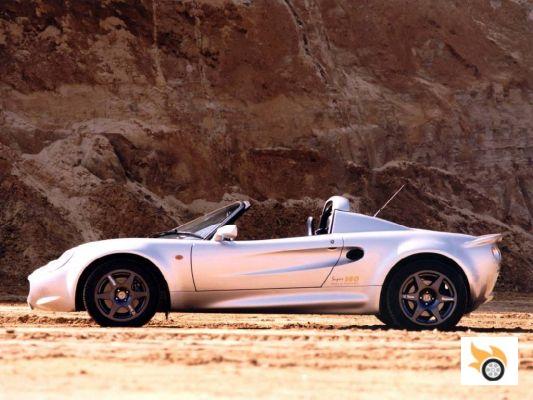
Be that as it may, it's a car that combines two or three great technical facets: It has an excellent weight distribution, a very low polar moment of inertia, a very low centre of gravity, and very light unsprung masses (suspension arms, brakes, rims and tyres), which allows for a simply great set-up.
Living with him day by day
With the roof on you'll have to do some contortions to access the interior, but once you're in the seat you'll feel comfortable. Two good-sized adults will bump shoulders when sitting side by side, and you'll brush against your passenger's leg when shifting gears.
But otherwise, especially if you're using it for commuting alone, for example, it won't be a problem. The heating (and air conditioning, if you have that option), aren't as effective as a modern air conditioner. Sound insulation isn't anywhere near that of a modern car either, but those are tolls to pay.
The suspension isn't stiff like a tablet or a modified car. In fact, it copes well with the potholes of modern cities. Rearward vision is a bit tricky, and other road traffic is intimidating, because it's so high above you.
But the smile when you go to refuel is that you can make very very low consumption of six or seven liters per hundred kilometers, unbecoming of a sports car of its performance. The boot is scarce, but enough for everyday life, although it is not a car to go on holiday for a week with him.
Attacking curves
But the Elise is for fun, and it's on the open road, on a mountain pass, where you really get the most out of it. It's a car that doesn't need to visit a track to make you smile, and that's without going over the legal speed limit.
It changes direction telepathically, it communicates the available grip like no other car does through the seat and steering wheel, it has a great damping compromise between hardness and absorption capacity, and its rear end is willing to play with you if you ease off the throttle at full throttle (be careful, this can be dangerous if you don't know how to control it, remember there are no electronic driving aids).
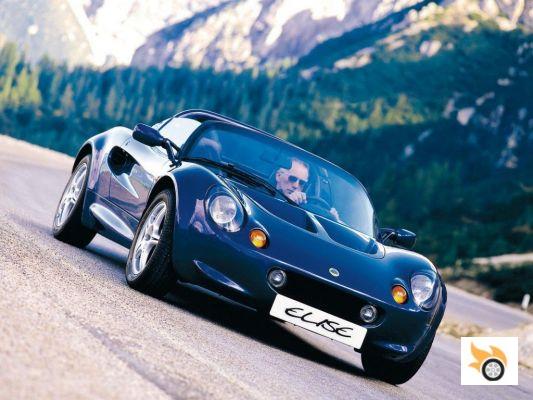
Driving an Elise re-discover the essence of driving. It's like a four-wheeled motorbike, where you "feel" the road, where you understand the rhythm, where you flow with the curves. Where speed is not so important, where effectiveness (and it has a lot of it) is not the factor that makes you fall in love with it, but the way it does things.
It is, quite simply, the best car I have ever driven on a mountain pass. And believe me... I've driven a few, and quite a few more powerful ones, but nothing comes close to it in "real" road satisfaction.
Weaknesses
The Elise's great formula has its drawbacks. The main one comes from its engine. It's well known that the cooling system of Rover's K series engines is a real pain. It tends to overheat and load a very poor quality head gasket at source, which in turn can lead to cylinder head deformation.
It is a problem that, over the years and the arrival of new gaskets, has been rectified, but if you're going to buy one, check that the cylinder head is flat and not bent, that the compression in the cylinders is correct, and that there is no oil in the coolant. Changing the original gasket for the new improved one is a great idea. With this under control, and watching the timing and maintenance of the engine, you have Elise for a while.
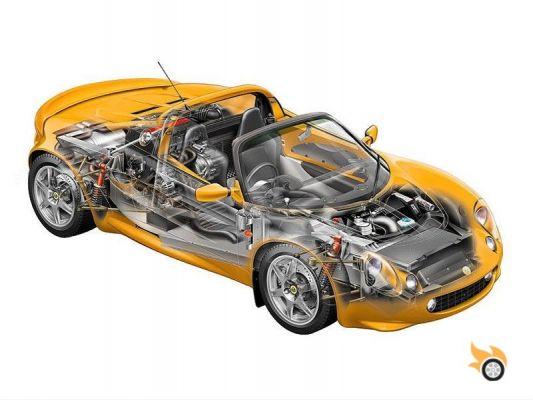
For the rest of aspects not related to the engine, it is a car that does not give much war. It can not rust, as it is made of aluminum and fiber, although the supports of some elements such as headlights do rust and corrode (they are made of steel) and deserve your attention.
The gear shift is by cable, and the ropes can get out of adjustment. If they are badly stretched, they cause problems, so it is advisable to change them before damaging the gearbox. Suspension bushings and bearings suffer if the car is used intensively or on the track, so unexpected geometry changes can happen, with erratic behaviour, creaking in compression and extension of the suspension and other "strange" things. A well cared for Elise shouldn't have these things like this. Suspension bearings last about 60,000 km at best, so in any case, make your budget with this in mind.
Buying one
The best thing about an Elise S1 is that right now you can get one for between 15.000 and 20.000€ (especially if you import it from outside Spain, from countries like Italy, for example).
We have already told you that the fuel consumption is low, the insurance is not expensive either, and only the difficulty of finding certain spare body parts can get you into trouble, although there are suppliers like this one, which are very reliable and have good prices.
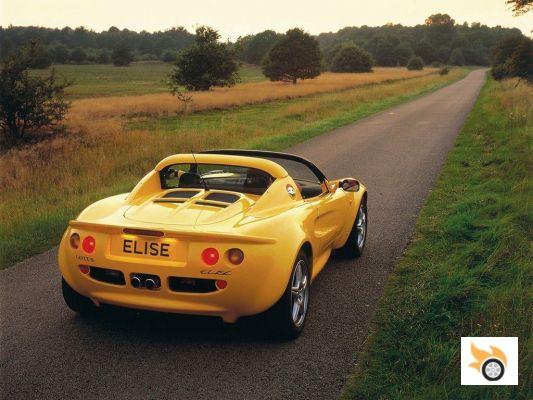
Getting one will give you a great car for cornering, much more fun than any GT86, Genesis Coupe or 370Z you can think of, at a fraction of the price, and with the added value of aesthetic exclusivity. There is nothing on the market that has such a well tuned chassis, that offers such positive sensations, that makes you fall in love with it as this Lotus does.
It has its drawbacks, of course. It's a car-caprice, where you don't have emergency space in the back, a car that is also difficult to find on sale, and that you will hardly be able to use to go far away from home on holiday, but... If you get one you will never regret it.
By the way, if you don't like the 118 hp (which I doubt, as the S1 with that engine is probably the most balanced), a 111S, with almost 150 and variable distribution engine will probably satisfy you more, although its more "racing" approach sacrifices a bit of comfort and simplicity on the road in favor of a bit more efficiency.
Article originally published in October 2013, retrieved for Pistonudos.
























